As reported by Energy Voice yesterday, disappointment prevails at Shell after the Offshore Petroleum Regulator for Environment and Decommissioning (OPRED) declined to sanction the Environmental Statement for the development of Jackdaw.
Shell had earmarked the Jackdaw discovery in block 30/02 as a so-called “longevity bridge”, the development of which would allow more time to both reduce Scope 1 emissions at Shearwater – the tie-back candidate – as well as being an enabler for a future hydrogen energy hub at St Fergus Terminal in Scotland.
Given the decline of Shearwater production, Shell also mentioned that there is a finite time window in which to economically develop the 120-250 MMboe discovery. This now comes under more pressure.
Complex reservoir architecture
Jackdaw was discovered in 2005 through drilling 30/02a-6 by ConocoPhillips. It was subsequently appraised by wells 30/02a-7 and 30/02a-8 in 2008 and 2011 respectively.
Based on the surface locations of the two appraisal wells, it seems as if the discovery was only tested in the northeast corner, but documents related to the 30/02a-8 well disclose that it drilled a fault block situated between the 30/2a-7 and 30-2a-6 wells.
The main reservoir in Jackdaw is a stack of Upper Jurassic turbiditic sandstones intercalated in the Heather Formation. One of the reasons why the field may not have been developed earlier is the fact that the field is heavily compartmentalised by a set of rotated fault blocks. These faults are interpreted as gravity structures due to the development of a decollement in the Pentland Shale below the reservoir units as a result of salt withdrawal in both the north and south of the field.

So, although the salt withdrawal led to the formation of the positive structure that Jackdaw now represents, it probably has had implications on reservoir connectedness within the closure itself.
The main fluid in the HPHT Jackdaw reservoirs is gas-condensate – the top of the reservoir section in well 30/02a-6 is situated at an impressive 5,250 m depth. The development concept includes a four-well design, tied back to Shearwater through a “not permanently attended” wellhead platform.
Judy option
A few months ago, Energy Voice already reported that the regulator had asked Shell why it had chosen to export the gas via Shearwater and not via the Harbour-operated Judy facility closer by (see map above). According to OPRED, there are clear benefits to the Judy option, including avoiding significant offshore vent emissions from the amine unit.
Let’s see in which direction Jackdaw will fly in the months to come.
HENK KOMBRINK





